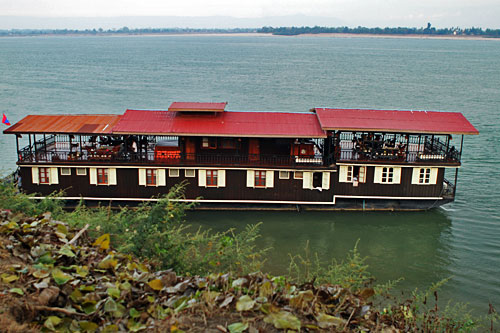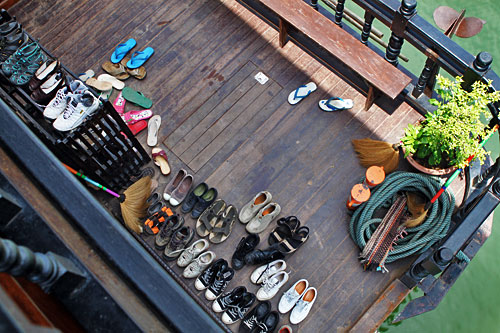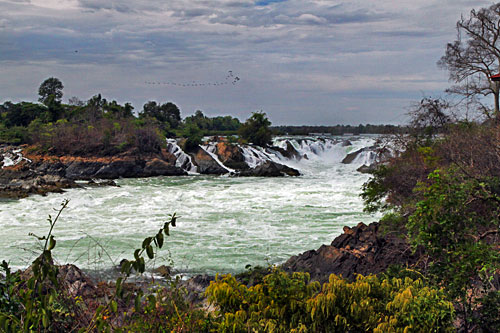I rubbed the gunk from my eyes and stepped off the overnight sleeping bus in Pakse, Laos. A pack of cutthroat taxi drivers instantly surrounded me, jostling and jockeying. “Where you go?” shouted one. “I give you best price,” insisted another. “Sinouk Cafe,” I answered groggily. The taxi drivers exchanged a knowing look that should have tipped me off. Fortunately, one use of the filthy, overflowing toilet in the bus during the night had convinced me to wait until morning and I was squirming to find a bathroom. By the time I returned, not a taxi driver was in sight, so I hefted my backpack and asked directions to the cafe where I was supposed to meet up with my fellow passengers for the Vat Phou Cruise to Four Thousand Islands. It was less than two blocks from the bus station, an easy walk that would undoubtedly have cost me dear if I’d hired a taxi.
With two hours to wait, I cracked open my laptop and settled into an easy chair with a Cappuccino and pastry. Other passengers trickled in and gathered in groups, all chatting in French, and it was soon apparent that I would be the only English speaking guest on the cruise. Though languages come easy to me, French is not among my repertoire and I wondered how I would get through the next three days, since none of my fellow passengers seemed to speak English.
After a briefing (in French) I followed the Mekong Cruises representative down to the river where we boarded a longtail boat that would carry us to the Vat Phou cruise ship. Having been reassured that an English speaking guide would join me on the boat, I tuned out the unintelligible French chatter and focused on the scenery. Unlike the mud-churned, rapids-laden Mekong River I had experienced during the Luang Say Cruise in northern Laos, here the river ran glass-smooth and emerald green. Fish jumped, sending concentric circles racing across the mirrored surface, and hawks screeched overhead, putting us on notice that we were intruders in their domain. Rather than jutting rocks, the southern reaches were pierced by innumerable sand islets that appear and disappear as waters rise and fall with the seasons, earning the area its nickname of Four Thousand islands.

Around a final bend, the Vat Phou boat came into view. Originally a ferry that carried teak wood between Vientiane and the south of Laos, in 1993 the steel-hulled teak barge was converted into a luxurious floating hotel. As we slid alongside I registered my initial impressions. Frilly. French. Like a giant, top-heavy wedding cake. Could this boat possibly stay upright? I climbed aboard, deposited my shoes on the lower deck for the duration of our cruise, and climbed to the upper deck for another briefing, also in French.

We enjoyed a gourmet lunch as the captain motored toward Champasak township and the Vat Phou Ruins, a majestic pre-Angkorian 10th century temple complex regarded as the most important ruin in Laos. Just as we were finishing up he eased the giant vessel out of the main channel and gently bumped the sand embankment, allowing us to disembark and climb aboard tuk-tuks for a 30 minute ride to the ruins. This particular site was chosen because it sits at the base of a curiously shaped mountain topped by a 45-foot high monolith that was revered as a natural lingam (phallic symbol) of the Hindu god Shiva. The Chenla Empire, a great civilization stretching south into Cambodia, north and west into northern Thailand and as far as Burma was responsible for the building of the original temple between the 6th and 12th centuries. Nothing remains of the once great city of the Chenla Empire, since all but religious sites were built of wood.
Between the 11th and 12th centuries, Khmer architects restored and rebuilt many sections of the temples and they now have many features characteristic of the ruins at Angkor Wat in Cambodia – stone causeways, decorative lintels and many carvings. Today, the two large palaces on the valley floor are slowly being repaired and restored through the UNESCO World Heritage project, one by a team of French archeologists and the other by an Indian team, each of which has employed vastly differing restoration techniques. The Indian teams tore the structure down to its foundations and numbered each stone, then rebuilt it from the ground up. French teams left approximately 50% of the structure in place, stabilized the existing masonry, and built up from there. The difference between the two is startling. The French site seems extremely stable, with well-fitted seams between stones, while the blocks of the Indian site are ill-fitted and its unsupported walls seem on the verge of toppling.

Slowly, we ascended the dessicated hill under a sweltering sun, picking a careful path across giant stone slabs that had heaved and jumbled over the centuries. At the top, renewed by baptism from an ancient spring and a magnificent view of the valley floor, we made offerings at a small temple that held a gold-draped sitting Buddha. Following our guide into the surrounding forest, we alternately cringed at stone altars used for human sacrifice and marveled at an intricate carving of Vishnu and Brahma kneeling on either side of Shiva, the destroyer, considered to be the most powerful of the Hindu gods. The image stayed with me through dinner and followed me into my teak-paneled cabin, where I threw open the windows and sank into my heavenly soft bed. I pondered the mystery of the triumvirate, the only known carving of its kind, wondering whether these three most important Hindu gods were precursors of the Christian trinity, until the gentle rocking of the boat and drone of cicadas lulled me to sleep.
The first rays of dawn pierced my window, waking me from a deep and blissful sleep. Eager to savor every moment of the luxurious cruise, I jumped into my clothes and raced to the upper deck for another scrumptious breakfast. My new acquaintances waved me over to their table, where I tested a smattering of French I had learned the previous evening. “Bonjour!” I exclaimed. “Comment allez-vous” – how are you – they replied politely. “Tres bien.” Thirty seconds of uncomfortable silence ensued; they were too polite to exclude me and I was exhausted from not being able to understand them. But we quickly found a compromise; I pointed at whatever I wanted and they handed it to me, interrupting their conversation long enough to tell me the French word for whatever I requested.
On the stroke of nine our boat pulled up to Huei Thamo where the locals welcomed us with broad smiles and posed for photos. Just beyond the village we entered a grove of towering ancient trees and thick vegetation that had all but consumed the small Oum Moung temple. Built toward the end of the 9th century, these ruins paid homage to god Rudani, consort of Shiva. We continued cruising south toward the Cambodian border, stopping at Duatai, a village so small that it is not even shown on area maps. Mekong Cruises has adopted this unspoiled community, providing assistance for its 600 residents in return for providing passengers with an up-close look at their lives. We wandered along footpaths that criss-crossed the community, through backyards where fishermen mended nets and women sat on the ground, weaving bundles of palm fronds into thatch roofing. On the single sand road, another group made charcoal over an open fire, while further down the road a lone motorcycle waited for a fill-up next to the community’s gas station – a wooden shack with a hand pump and a 50-gallon drum of fuel.
On the third morning, as we approached the Cambodian border, our boat cruised at a noticeably slower speed. Now deep within the area known as 4,000 islands, the river broadens behind Pha Pheng Waterfalls, a one kilometer long ledge that drops around 90 feet into the lower basin, separating the upper Mekong from the lower Mekong and completely sealing off the two sections for navigation and transport of goods.
When France annexed Laos into its Indo-China colony in the late 19th century, they hoped to transport valuable goods from Yunnan, in southern China, to Vietnam, for export. The falls of Khone Pha Pheng, and other similar, smaller ones at this point in the river, made that dream impossible to fulfill. The French solved the problem with a railroad that bypassed the falls. It operated until 1949, when a road along the left bank of the river allowed for the faster transport of goods. Gradually the railroad fell into disrepair, although the old stone bridge over which the steam locomotives pulled their loads is now used by autos.

Finally, with the river broadening and becoming shallower, we reached the limits of navigable water. Disembarking at Don Det Island, we again hopped into tuk-tuks for a short ride over the historic railroad bridge and onto Don Khone Island, where we poked among the remains of an old steam locomotive rusting away in the tropical humidity, and ended our tour at the impressive Pha Pheng Waterfall. Back in Pakse there were hugs all around, with admonitions to remember the French I had learned. “Au revoir,” I said, waving goodbye. All the way back to the hotel I reviewed my new French vocabulary: c’est bonne (it’s good), bonne nuit (good night), avoir une bonne journée (have a good day), c’est delicius (it’s delicious), gelée verte (mint jelly)…just don’t ask.
Mekong Cruises kindly hosted the author on the Vat Phou Cruise. However, the receipt and acceptance of complimentary items/services received will never influence the content, topics, or posts in this blog. I write the truth, the whole truth, and nothing but the truth and in this case, Mekong Cruises is one of the best tour operators I have ever had the pleasure to work with. Their administrative staff was well organized, their boat crew was highly trained to meet every need of the passengers, and I simply cannot say enough about the skills of the captain, who expertly docked the boat against sandy shores that I would have thought impossible to approach.

Hello Barbara,
I am considering booking on the Vat Phou. It looks stunning, but I am concerned it may be the wrong demographic for me. I am 39yo – will I be surrounded by older couples and families, or were there some other solo travellers on your trip (albeit French?!).
If the Vat Phou would not be suitable, is it possible for you to recommend any cruises down the Mekong to 4000 islands that may be in the 35 – 50 age bracket please? (not backpacker party boats though!)
Many thanks – and congratulations on your fabulous blog!
Rebecca
Hi Rebecca: So glad you enjoy my blog! I absolutely encourage you to book the Vat Phou cruise. The one I happened to take had been was booked by a French group; I was the sole English-speaking passenger and the only one not part of the group, so I don’t think it was representative of the normal demographic mix. I also sailed with the company on their route from northern Laos to Luang Prabang, and the passengers on that cruise were a mix of all ages, right down to families with young children and other solo travelers. I believe this is probably the norm, rather than an older group. However, because of the higher price point, I can assure you that you will see very few budget backpacker types on their trips – they all take the bare-bones boats. I can’t recommend Mekong Cruises highly enough. They really know what they’re doing.
I did a Mekong river cruise but its not as extensive as this one. Mine was just the market places and farms in Cai Be and Can Tho. We did the home stay option and it was wild and interesting. I’d love to do a Vietnam to Laos river cruise soon though!
Not sure if I missed it or not – but did the English speaking guide ever appear?! Sounds like a lovely yet isolating cruise! Then again – that’s sort of the norm in solo travel! The boat did look lovely!!
Hi Sherry – Yes, the English speaking guide did appear and he was a
wonderful young man. Had him all to myself for the entire three days so I
learned so ,much more than I normally would have.
The photo of the Pha Pheng waterfall is my favorite from this set – it looks like a painting!
Sounds beautiful. I love the character-filled appearance of the vessel and the way that the folks on board adopted you despite the language issues. A bit of patience and most things work out well with language.
Barbara, that trip would have been absolutely stunning! 4000 islands in Laos is one of my favorite destinations but I never experienced a trip quite like this to get there. I find the southern part of Laos a very under-rated area in South East Asia.
Hi Samuel: I totally agree with you. Many parts of Laos, which was a
virtually unknown tourist destination 15 years ago, are already overrun with
tourists. But the southern area, especially the islands in the 4,000 Islands
area, are still pretty sleepy. Don Khone was absolutely lovely!